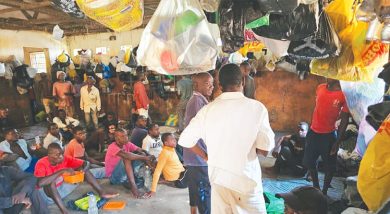Pollutants choking residents, workers
E
sther Chirwa, 59, of Mapanga in Blantyre has for seven years suffered bouts of sore throat, headache and flu after allegedly inhaling toxic emissions from a neighbouring factory.
If you have been to the area, a strong stench from the emissions engulfs the air and welcomes you from Chiradzulu Turnoff, all the way to the Malawi Prisons Service Training School on the Zomba-Blantyre Road.
“I have been struggling with these emissions for long. At times, I cannot even get out of my house because they become so intense that I develop a serious cough,” she says.
For the Chirwa family, breathing freely in a clean environment is a luxury.
As the factory is built in a residential area, the family got robbed of clean air in 2017.
Esther cannot open windows from the backside of her house since the emissions flow directly into her yard.
Bad enough, her 91-year-old mother who has stroke needs fresh air which is denied due to the factory’s presence.
She said: “I believe these emissions compounded my mother’s health resulting in her stroke.”
With family members constantly developing coughs and flu, they attribute it to the toxic emissions.
The nameless factory uses car battery cells, acid and aluminium to produce yet to be identified block-like structures for export to China.
Walking into Chirwa’s compound, the emission of fetid substances gets stronger with every step.
This reporter, who visited the compound on Wednesday, had to wear a face mask.
Though their fence was elevated to try to shield the smell, the factory discharge easily flows into the yard.
Unfortunately, the Chirwa’s family cannot relocate from the house on their plot.
The Mapanga putrid smell from the emissions has also bothered Mryam Sibande, another resident.
She said: “Ever since this factory started operating in this area, I have been experiencing similar illnesses as the Chirwa’s. When I go to a different area, I get better.”
Sibande’s health passport shows bouts of flu and cough, treated at Chiradzulu District Hospital for over five times.
Another resident Jonathan Phillipo said their efforts to seek the interventions of Blantyre City Council (BCC), constituency and ward leaders have proved futile.
Jenifer Jere who recently moved into the area is pondering relocating due to frequent headaches she is experiencing.
She said: “I know my constant headaches are a result of what I am inhaling.”

We managed to sneak into the factory compound with a man identified as Mr. Banda who went to sell used car batteries and aluminium. He had five sack bags of the used products.
Banda told us that he sells his merchandise at K750 per kilogramme.
Inside the compound, there is a pile of used car battery cases and other waste heaped from end to end.
Emissions from the lowly built factory could be seen flowing from the gaps between the wall and roof.
We walked about 400 metres before a Chinese woman and one of the owners, walked out of one of the buildings inside the compound.
Upon noting the media presence, she chased us.
We returned on a separate day when a guard at the gate said no media was allowed inside the premises.
A worker, who opted for anonymity, said they do not know the use of the block-like structures.
He, however, described the factory as hazardous to them since they are not given protective clothing.
He said since he started working there, he suffers constant headaches and flu.
A sign on the fence bears no name or contact details, only inscriptions that they buy aluminium and sell bicycles.
Appalled by the emissions, community members petitioned BCC in 2020 to close it, since they do not allow factories to be built in residential areas.
“The emissions produced from this factory engulf our houses like fog at times since 2017. These emissions contain acid,” reads the petition dated November 24 2020.
Blantyre City East parliamentarian John Bande said it is sad that the council has failed to act on the matter.
He claimed: “We went to the factory with community members and BCC officials, but it seems the owners are feared. Perhaps the community should mobilise themselves to close the factory because people are being exposed to illnesses and some are dying.”
BCC chief executive officer Dennis Chinsewu on Wednesday, however, asked for more time before responding.
He claimed it was the first time he heard about such concerns.
But when we followed up on Friday, he was not ready with a response.
Kamuzu University of Health Sciences public health expert Professor Adamson Muula said such issues are not rare, yet, dangerous to human health.
He said: “Apart from the constant headaches and cough, they [residents] may also have skin and eye problems. Whether this is short-term or long-term will depend on what chemicals are in the fumes and for how long they are going to be exposed to these.”
Pollution in residential areas contravenes Section 4 (1) of the Environmental Management Act which states that every person has a right to a clean and healthy environment.
The Act says the duty to enhance and safeguard the environment includes the duty to inform the authority or relevant lead agency of all activities or phenomena that may affect the environment significantly and shall be exercisable by individuals, public authorities, non-governmental organisations or local environment and natural resources committees.
It reads in part: “In furtherance of the right to a clean and healthy environment and the enforcement of the duty to safeguard and enhance the environment, the authority or lead agency so informed or any person interested in enforcing the right to a clean and healthy environment shall be entitled to bring an action against any person whose activities or omissions have or are likely to have a significant impact on the environment.”
Studies by the University of Strathclyde show that air quality in Malawi is considered moderately unsafe with the country’s annual mean concentration of PM2. 5 is 24 µg/m3, which exceeds the recommended maximum of 10 µg/m3.
This emanates from factories across the country’s four cities of Blantyre, Zomba, Lilongwe and Mzuzu, according to the studies.
This is causing harm to health and the environment through toxic emissions being inhaled by both humans and plants.
Yesterday we tried to engage environmental law expert Justin Dzonzi who was not available on his known mobile number.






Your blog is a garden of laughter, and I’m grateful for the seeds you plant with every post!